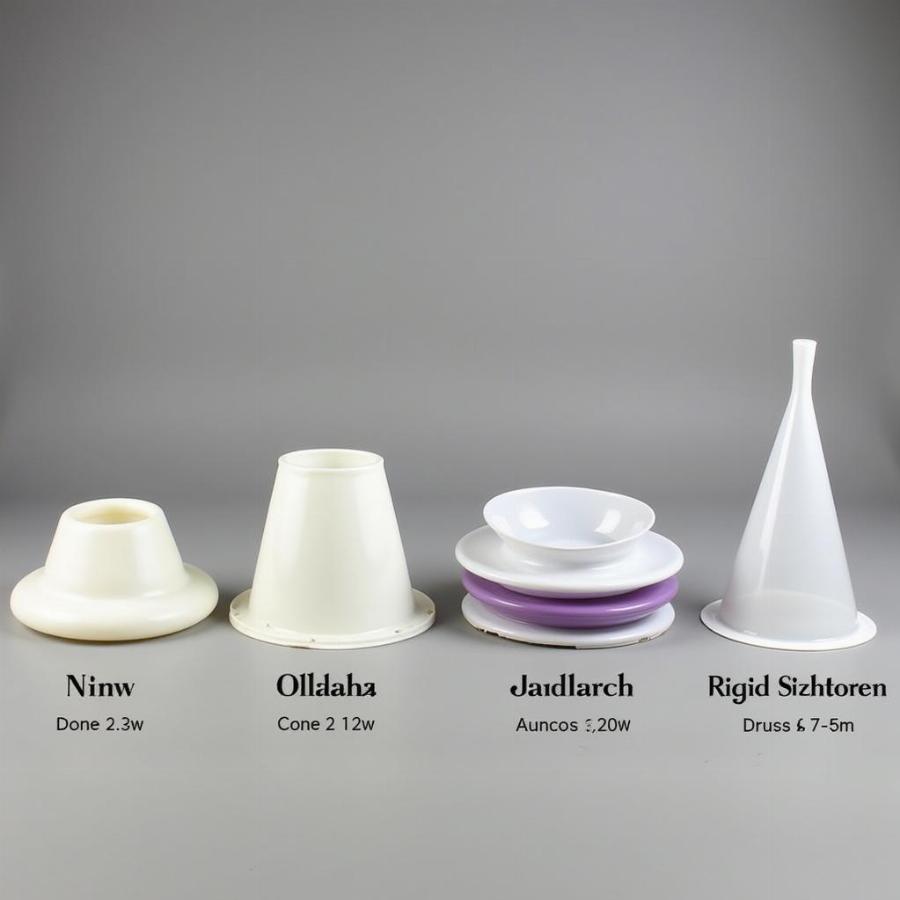The term “cone head dog” often refers to dogs wearing an Elizabethan collar, sometimes called a “cone of shame.” These cones are commonly used after surgery or injury to prevent dogs from licking or biting at wounds, stitches, or bandages. Understanding why and how to use a cone, along with managing your dog’s comfort and well-being while they wear one, is crucial for a smooth recovery.
Why Your Vet Might Prescribe a Cone Head for Your Dog
Veterinarians frequently prescribe cones to protect surgical sites, hot spots, or injuries. Without a cone, a dog’s natural instinct is to lick or chew the affected area, which can introduce bacteria, disrupt healing, and even cause further injury. A cone acts as a physical barrier, preventing access to the wound and promoting faster, cleaner recovery. It’s essential to follow your veterinarian’s instructions regarding cone usage.
Choosing the Right Cone Head for Your Dog
 Các loại vòng chống liếm cho chó
Các loại vòng chống liếm cho chó
Several types of “cone heads” are available, ranging from the traditional hard plastic cone to softer, more flexible options like inflatable collars and fabric e-collars. dog cone on head The best choice depends on your dog’s size, temperament, and the nature of their injury. Some dogs tolerate the traditional cone well, while others may find it cumbersome and stressful. Softer cones can be more comfortable, but some dogs may still be able to reach their wounds with them. Your veterinarian can help you select the most appropriate cone for your dog’s specific needs.
Helping Your Dog Adjust to the Cone of Shame
Wearing a cone can be a strange and sometimes frustrating experience for dogs. They may bump into furniture, struggle to eat or drink, and have difficulty navigating their environment. Patience and understanding are key during this adjustment period. dog crying memes Ensure your dog has easy access to food and water bowls, perhaps using raised dishes or assisting them with feeding. Provide a comfortable and safe space where they can rest without the cone bumping into objects. Positive reinforcement, such as gentle petting and praise, can also help your dog associate the cone with positive experiences.
Cone Head Alternatives and Additional Support
pillows for dogs head While the cone is often the most effective solution, alternatives exist for some situations. Surgical recovery suits or inflatable donuts can provide similar protection while offering more mobility and comfort. However, it’s essential to consult your veterinarian before considering any alternatives, as they may not be suitable for all injuries or dogs. If your dog exhibits excessive stress or anxiety while wearing a cone, your veterinarian may recommend medications or other strategies to help manage their discomfort.
Common Questions about Cone Head Dogs
-
How long will my dog need to wear the cone? This depends on the injury and your veterinarian’s recommendations. It could range from a few days to several weeks.
-
Can my dog sleep with the cone on? Generally, yes. However, ensure the cone allows your dog to lie down comfortably.
-
Is it safe to leave my dog alone with the cone on? Yes, for short periods. Ensure your dog has access to water and a safe space.
-
What if my dog keeps trying to take the cone off? Make sure the cone is properly fitted. If the problem persists, consult your veterinarian.
-
How do I clean the cone? Most cones can be wiped down with a damp cloth and mild detergent.
Expert Insights on Cone Usage in Dogs
Dr. Emily Carter, a renowned veterinary surgeon, emphasizes the importance of cone compliance: “While it might seem like a minor inconvenience, the cone plays a vital role in protecting your dog from self-inflicted harm during healing. Strict adherence to cone usage can prevent complications and ensure a smoother recovery.”
Conclusion
The “cone head dog” look, though comical, serves a crucial purpose in protecting your furry friend’s health. Understanding the reasons behind cone usage, choosing the right type of cone, and helping your dog adjust to wearing it can make the recovery process significantly easier for both of you. Always consult your veterinarian for guidance on cone usage and any concerns about your dog’s well-being during recovery. ear cover for dog bathing
FAQ: More Questions About Dog Cones
- Can my dog play with other dogs while wearing a cone? Supervised play is generally okay, but avoid roughhousing.
- What should I do if the cone gets damaged? Replace it immediately to ensure continued protection.
- Can I make a homemade cone for my dog? It’s best to use a veterinarian-approved cone for proper fit and safety.
Other Articles You Might Find Helpful:
Beaut Dogs is your trusted source for all things related to dog care, providing expert advice and information to help you navigate the wonderful world of dog ownership. For personalized guidance and answers to your specific questions, contact us at Email: [email protected]. Beaut Dogs is committed to helping you provide the best possible care for your beloved canine companion.